Accept all cookies Accept only essential cookies See our Cookie Notice

About ESA
The European Space Agency (ESA) is Europe’s gateway to space. Its mission is to shape the development of Europe’s space capability and ensure that investment in space continues to deliver benefits to the citizens of Europe and the world.
Highlights
ESA - United space in Europe
This is ESA ESA facts Member States & Cooperating States Funding Director General Top management For Member State Delegations European vision European Space Policy ESA & EU Space Councils Responsibility & Sustainability Annual Report Calendar of meetings Corporate newsEstablishments & sites
ESA Headquarters ESA ESTEC ESA ESOC ESA ESRIN ESA EAC ESA ESAC Europe's Spaceport ESA ESEC ESA ECSAT Brussels Office Washington OfficeWorking with ESA
Business with ESA ESA Commercialisation Gateway Law at ESA Careers Cyber resilience at ESA IT at ESA Newsroom Partnerships Merchandising Licence Education Open Space Innovation Platform Integrity and Reporting Administrative Tribunal Health and SafetyMore about ESA
History ESA Historical Archives Exhibitions Publications Art & Culture ESA Merchandise Kids Diversity ESA Brand Centre ESA ChampionsLatest
Space in Member States
Find out more about space activities in our 23 Member States, and understand how ESA works together with their national agencies, institutions and organisations.
Science & Exploration
Exploring our Solar System and unlocking the secrets of the Universe
Go to topicAstronauts
Missions
Juice Euclid Webb Solar Orbiter BepiColombo Gaia ExoMars Cheops Exoplanet missions More missionsActivities
International Space Station Orion service module Gateway Concordia Caves & Pangaea BenefitsLatest
Space Safety
Protecting life and infrastructure on Earth and in orbit
Go to topicAsteroids
Asteroids and Planetary Defence Asteroid danger explained Flyeye telescope: asteroid detection Hera mission: asteroid deflection Near-Earth Object Coordination CentreSpace junk
About space debris Space debris by the numbers Space Environment Report In space refuelling, refurbishing and removingSafety from space
Clean Space ecodesign Zero Debris Technologies Space for Earth Supporting Sustainable DevelopmentLatest
Applications
Using space to benefit citizens and meet future challenges on Earth
Go to topicObserving the Earth
Observing the Earth Future EO Copernicus Meteorology Space for our climate Satellite missionsCommercialisation
ESA Commercialisation Gateway Open Space Innovation Platform Business Incubation ESA Space SolutionsLatest
Enabling & Support
Making space accessible and developing the technologies for the future
Go to topicBuilding missions
Space Engineering and Technology Test centre Laboratories Concurrent Design Facility Preparing for the future Shaping the Future Discovery and Preparation Advanced Concepts TeamSpace transportation
Space Transportation Ariane Vega Space Rider Future space transportation Boost! Europe's Spaceport Launches from Europe's Spaceport from 2012Latest
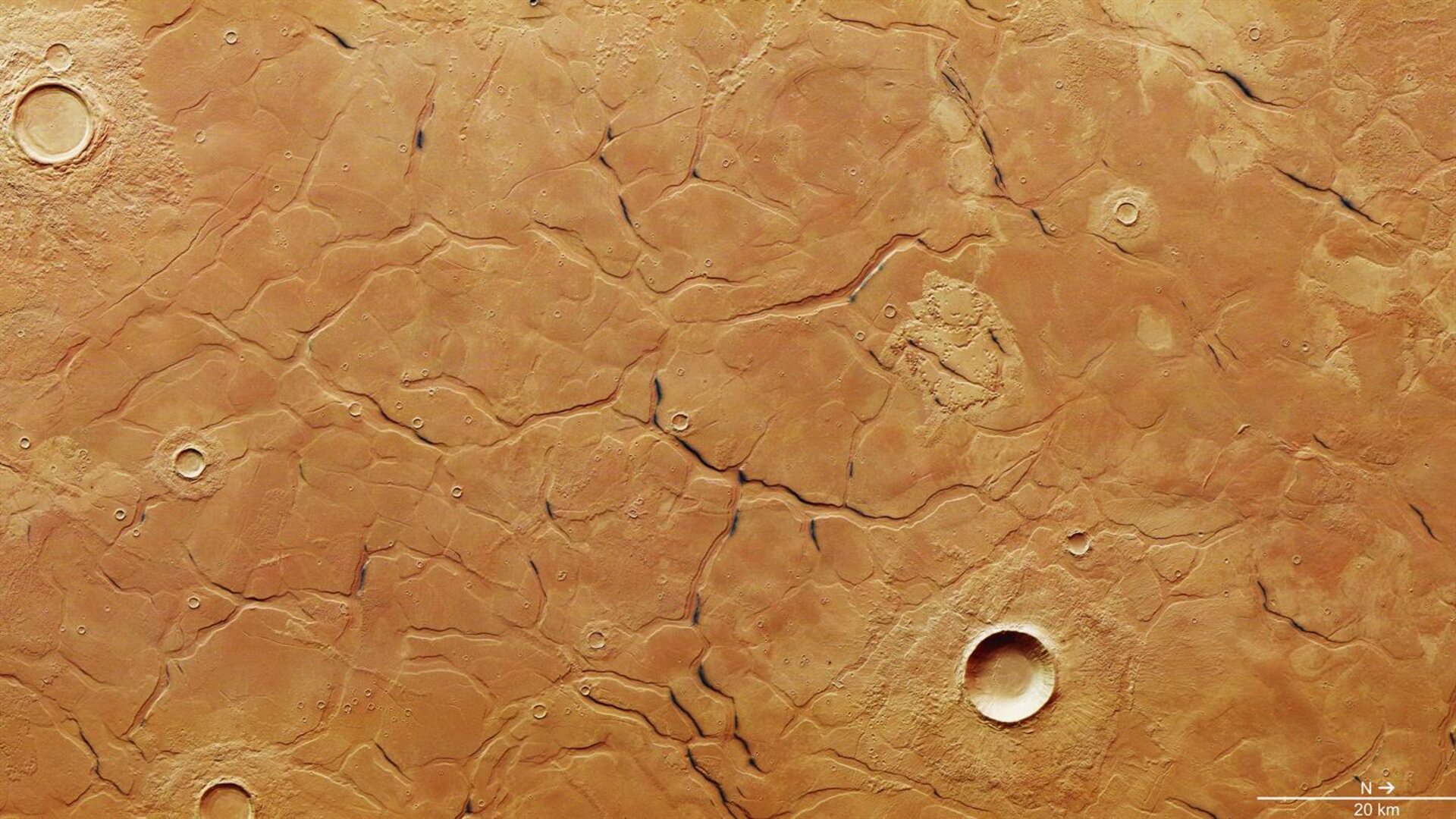
Adamas Labyrinthus
Thank you for liking
You have already liked this page, you can only like it once!
This labyrinth-like system of troughs and plateaus was imaged by ESA’s Mars Express on 21 June 2016.
It shows part of a region known as Adamas Labyrinthus, which is found in Utopia Planitia in the northern lowlands of Mars. Here, the randomly shaped blocks vary in size from 5–20 km across and are separated by cross-cutting troughs with widths of up to 2 km.
The pattern is similar to that observed in some offshore locations on Earth, supporting an idea that the scene here results from the deposition of fine-grained sediments in an ocean.
The formation of such polygons with surrounding troughs has been attributed to a number of varied processes, including collapse under gravity, the expulsion of fluid from the porous sediments as they are being compacted, low friction between the sediments resulting in mass wasting, and local tectonic activity extending the blocks apart. The underlying topography of the surface below may also play a role.
One idea for the scene shown here on Mars is that sediment slurries were deposited during catastrophic flooding on an ice-rich surface, and contracted into the polygons as the sediments were compacted and expelled their fluids.
Later, tectonic activity and the gradual sublimation of buried ices could have caused gradual widening and deepening of the troughs between the giant polygons.
Icy material certainly played a role in this region’s appearance at some point: the larger impact craters show characteristic “pancake” debris blankets, which indicate heating and melting of a subsurface ice layer at the time of the impact.
In addition, some of the troughs show dark deposits, which may be ash layers being revealed from below a cover of dust-covered ice as Sun-facing slopes are gently heated.
The ground resolution of this image is about 15 m per pixel and the images are centered at 39ºN / 101ºE. For more images and details of this region, see the associated image release by the DLR German Aerospace Agency and by Freie Universität Berlin on 8 September.
-
CREDIT
ESA/DLR/FU Berlin, CC BY-SA 3.0 IGO -
LICENCE
CC BY-SA 3.0 IGO or ESA Standard Licence
(content can be used under either licence)
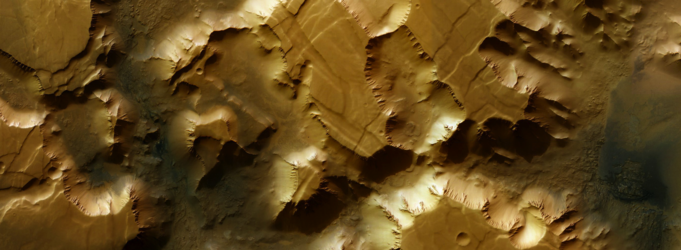
Noctis Labyrinthus mosaic

Noctis Labyrinthus context
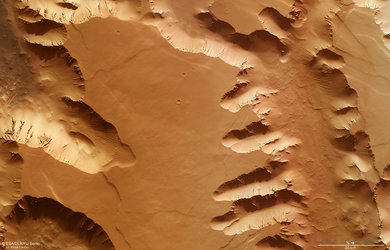
Noctis Labyrinthus plan view
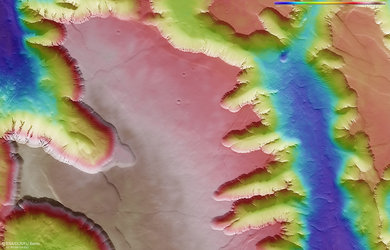
Noctis Labyrinthus topography
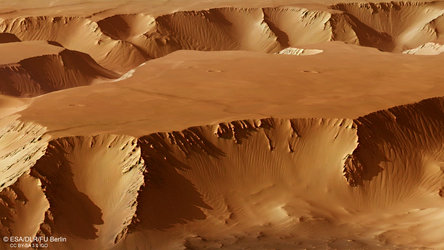














 Germany
Germany
 Austria
Austria
 Belgium
Belgium
 Denmark
Denmark
 Spain
Spain
 Estonia
Estonia
 Finland
Finland
 France
France
 Greece
Greece
 Hungary
Hungary
 Ireland
Ireland
 Italy
Italy
 Luxembourg
Luxembourg
 Norway
Norway
 The Netherlands
The Netherlands
 Poland
Poland
 Portugal
Portugal
 Czechia
Czechia
 Romania
Romania
 United Kingdom
United Kingdom
 Slovenia
Slovenia
 Sweden
Sweden
 Switzerland
Switzerland
























